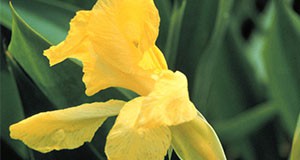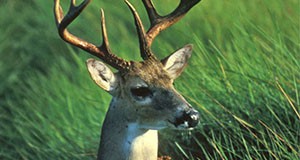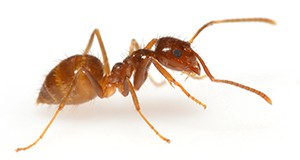
Plagiometriona clavata (Fabricius) is common and can be recognized easily by its general form and appearance. Written for Featured Creatures Collection by Robert E. Woodruff. Original publication date December 2006, revised August 2015. (Photo Credit: David Cappaert, www.forestryimages.org)
http://edis.ifas.ufl.edu/in710
Category: Ecosystems & Species
Pillbug, Roly-Poly, Woodlouse Armadillidium vulgare (Latreille) (Malacostraca: Isopoda: Armadillidiidae)
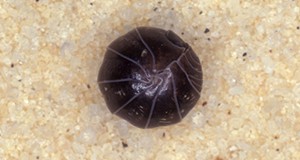 The roly poly is an isopod, a type of non-insect arthropod also known as a terrestrial crustacean. It is called a roly-poly because it rolls into ball when disturbed. This defensive behavior also makes it look like a pill, which is why it is sometimes called a pillbug. In Europe, the name woodlouse is used for both roly polies and sowbugs because these arthropods are frequently found under logs. Roly polies are nocturnal, though they may be found during the day in the soil or under debris. They are beneficial in the garden or landscape. This 3-page fact sheet about the humble roly poly was written by Julie A. Franklin, Morgan A. Byron, and Jennifer Gillett-Kaufman and published by the UF Department of Entomology and Nematology, August 2015. (Photo by James Castner, University of Florida)
The roly poly is an isopod, a type of non-insect arthropod also known as a terrestrial crustacean. It is called a roly-poly because it rolls into ball when disturbed. This defensive behavior also makes it look like a pill, which is why it is sometimes called a pillbug. In Europe, the name woodlouse is used for both roly polies and sowbugs because these arthropods are frequently found under logs. Roly polies are nocturnal, though they may be found during the day in the soil or under debris. They are beneficial in the garden or landscape. This 3-page fact sheet about the humble roly poly was written by Julie A. Franklin, Morgan A. Byron, and Jennifer Gillett-Kaufman and published by the UF Department of Entomology and Nematology, August 2015. (Photo by James Castner, University of Florida)
http://edis.ifas.ufl.edu/in1099
Blue Morpho Butterfly Morpho peleides Kollar
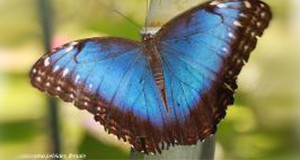
The blue morpho butterfly, also known as the peleides blue morpho or common blue morpho, is a brightly colored butterfly abundant in tropical environments in Central and South America. It can be seen flying in open areas such as paths, trails, forest edges, and rivers. In the United States, it is often featured in museums and zoos that have butterfly houses or butterfly rainforests. This five-page fact sheet about the popular butterfly was written by Haleigh A. Ray and Jacqueline Y. Miller and published by the UF Department of Entomology and Nematology, September 2015. (Photo credit: Andrei Sourakov, McGuire Center or Lepidoptera and Biodiversity, Florida Museum of Natural History, University of Florida)
http://edis.ifas.ufl.edu/in1101
Golden Canna: Canna flaccida
Golden canna is a native wetland plant with bright yellow flowers that can be found throughout most of Florida. This 4-page facts sheet details the golden canna’s biology, distribution and habitat, propagation, pests and diseases, and landscaping and other uses. Written by Edward F. Gilman, Carl J. Della Torre III, and Lyn A. Gettys, and published by the UF Department of Environmental Horticulture, June 2015.
http://edis.ifas.ufl.edu/fp102
Orchid Pollination Biology
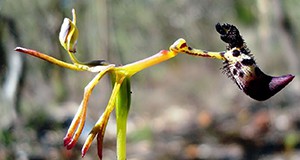
Orchids and their pollinators have developed fascinating co-adaptations that promote orchid pollination. This 6-page fact sheet details the various and often strange ways that orchids attract pollinators. The kinds of insects and animals that pollinate orchids and orchids’ reproductive anatomies and processes are also covered. Written by Haleigh Ray and Wagner Vendrame, and published by the UF Department of Environmental Horticulture, June 2015.
http://edis.ifas.ufl.edu/ep521
Tea Shot-Hole Borer Euwallacea fornicates (Eichhoff, 1868) (Insecta: Coleoptera: Curculionidae: Scolytinae)
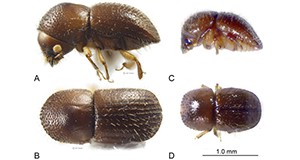
The tea shot-hole borer is an Asian ambrosia beetle introduced to Florida in the early 2000s. In Florida it does not have any known economic impact, but it is a serious pest of tea around the world and is one of the few ambrosia beetles that can infest healthy plants. The tea shot hole borer has a symbiotic relationships with the ambrosia fungus Fusarium ambrosium (Gadd & Loos), which is also a weak plant pathogen. This 4-page fact sheet includes diagnosis section with guidance for avoiding misidentification. Written by You Li, Andrea Lucky, and Jiri Hulcr, and published by the UF Department of Entomology and Nematology, June 2015.
http://edis.ifas.ufl.edu/in1090
A Sand Fly Lutzomyia longipalpis (Lutz and Neiva) (Insecta: Diptera: Psychodidae: Phlebotominae)
 The true sand flies are densely covered with setae, have long slender legs, and broad and pointed wings that are held erect at rest. Several phlebotomine species are vectors of the protozoan parasites in the genus Leishmania, that are the causal agents of leishmaniasis. Visceral leishmaniais is the most severe form of the disease, and is fatal to the human or dog host if untreated. This 6-page fact sheet was written by Maria C. Carrasquilla and Phillip E. Kaufman, and published by the UF Department of Entomology and Nematology, June 2015. (Photo credit: Cristina Ferro, Instituto Nacional de Salud, Colombia
The true sand flies are densely covered with setae, have long slender legs, and broad and pointed wings that are held erect at rest. Several phlebotomine species are vectors of the protozoan parasites in the genus Leishmania, that are the causal agents of leishmaniasis. Visceral leishmaniais is the most severe form of the disease, and is fatal to the human or dog host if untreated. This 6-page fact sheet was written by Maria C. Carrasquilla and Phillip E. Kaufman, and published by the UF Department of Entomology and Nematology, June 2015. (Photo credit: Cristina Ferro, Instituto Nacional de Salud, Colombia
http://edis.ifas.ufl.edu/in1091
Vespiform Thrips Franklinothrips vespiformis Crawford (Insecta: Thysanoptera: Aeolothripidae)

Franklinothrips vespiformis Crawford is a predatory thrips with a pantropical distribution. The distinctive red, humped-back larvae and fast-moving ant-like adults are predaceous on small arthropods. In addition to being easily mistaken for an ant, this beneficial thrips is unusual in that it constructs a silken cocoon within which it pupates. Males of this species are rare. This species is sold for use as a biological control agent in botanical gardens, zoos, interior landscapes, research greenhouses, nurseries with ornamental plants as well as outdoors in subtropical regions. This 4-page fact sheet was written by Runqian Mao, Yingfang Xiao, and Steven P. Arthurs, and published by the UF Department of Entomology and Nematology, March 2015. (Photo credit: Runqian Mao, UF/IFAS)
http://edis.ifas.ufl.edu/in1083
Black Scale Saissetia oleae (Olivier, 1791) (Insecta: Hemiptera: Coccoidea: Coccidae)
 The black scale is an important pest of citrus and olive trees. Originally from South Africa, this scale is now distributed worldwide. In Florida, black scale is found on citrus, cultivated olive, avocado, and many popular landscape plants. It is likely that black scale, like many invasive pests, was imported to the United States on infested nursery plants. Based on their small size and the unique life history of scale insects, these insects are difficult to detect and control. This 4-page fact sheet was written by Morgan A. Byron, Jennifer L. Gillett-Kaufman, and Sandra A. Allan, and published by the UF Department of Entomology and Nematology, March 2015. (Photo credit: Lyle Buss, UF/IFAS)
The black scale is an important pest of citrus and olive trees. Originally from South Africa, this scale is now distributed worldwide. In Florida, black scale is found on citrus, cultivated olive, avocado, and many popular landscape plants. It is likely that black scale, like many invasive pests, was imported to the United States on infested nursery plants. Based on their small size and the unique life history of scale insects, these insects are difficult to detect and control. This 4-page fact sheet was written by Morgan A. Byron, Jennifer L. Gillett-Kaufman, and Sandra A. Allan, and published by the UF Department of Entomology and Nematology, March 2015. (Photo credit: Lyle Buss, UF/IFAS)
http://edis.ifas.ufl.edu/in1082
Black Turpentine Beetle, Dendroctonus terebrans (Olivier) (Insecta: Coleoptera: Curculionidae: Scolytinae)
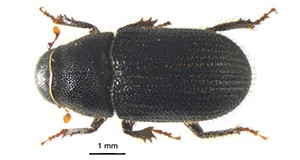 Black turpentine beetles bore into the inner bark of stressed or injured pines, where they breed and feed on phloem tissue. Adults are strongly attracted to volatile pine odors and readily breed in fresh stumps. In typical forests, infestations do not exhibit the rapid and devastating expansion characteristic of the closely related southern pine beetle, but in stands where stress conditions are frequent or persistent, black turpentine beetle can become a chronic pest and cause significant mortality over an extended period of time. Historically, black turpentine beetle has been a major pest of pines wounded or treated with herbicides in naval stores production. During the 1950s, black turpentine beetle damaged 37 million board feet of timber and contributed to the financial collapse of turpentine farms. This 5-page fact sheet was written by Albert E. Mayfield, John L. Foltz and Jiri Hulcr, and published by the UF Department of Entomology and Nematology, June 2015. (Photo credit Adam Black and Jiri Hulcr, UF/IFAS)
Black turpentine beetles bore into the inner bark of stressed or injured pines, where they breed and feed on phloem tissue. Adults are strongly attracted to volatile pine odors and readily breed in fresh stumps. In typical forests, infestations do not exhibit the rapid and devastating expansion characteristic of the closely related southern pine beetle, but in stands where stress conditions are frequent or persistent, black turpentine beetle can become a chronic pest and cause significant mortality over an extended period of time. Historically, black turpentine beetle has been a major pest of pines wounded or treated with herbicides in naval stores production. During the 1950s, black turpentine beetle damaged 37 million board feet of timber and contributed to the financial collapse of turpentine farms. This 5-page fact sheet was written by Albert E. Mayfield, John L. Foltz and Jiri Hulcr, and published by the UF Department of Entomology and Nematology, June 2015. (Photo credit Adam Black and Jiri Hulcr, UF/IFAS)
http://edis.ifas.ufl.edu/in636
An ambrosia beetle Xyleborus affinis Eichhoff, 1868 (Insecta: Coleoptera: Curculionidae: Scolytinae)
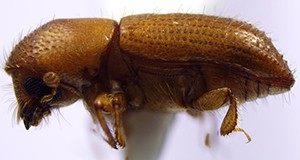 Xyleborus affinis is one of the most widespread and common ambrosia beetles in the world. It is also very common in Florida. Like other ambrosia beetles, it bores tunnels into the xylem of weakened, cut or injured trees and farms gardens of symbiotic fungus for food. Females lay eggs in the fungus-lined galleries and larvae feed exclusively on the fungi. Recent studies have shown that Xyleborus affinis can vector the fungus responsible for laurel wilt disease, which is lethal to numerous species of trees in the Lauraceae family. This 5-page fact sheet was written by Lanette Sobel, Andrea Lucky, and Jiri Hulcr, and published by the UF Department of Entomology and Nematology, June 2015. (Photo credit: Juri Hulcr, UF/IFAS)
Xyleborus affinis is one of the most widespread and common ambrosia beetles in the world. It is also very common in Florida. Like other ambrosia beetles, it bores tunnels into the xylem of weakened, cut or injured trees and farms gardens of symbiotic fungus for food. Females lay eggs in the fungus-lined galleries and larvae feed exclusively on the fungi. Recent studies have shown that Xyleborus affinis can vector the fungus responsible for laurel wilt disease, which is lethal to numerous species of trees in the Lauraceae family. This 5-page fact sheet was written by Lanette Sobel, Andrea Lucky, and Jiri Hulcr, and published by the UF Department of Entomology and Nematology, June 2015. (Photo credit: Juri Hulcr, UF/IFAS)
http://edis.ifas.ufl.edu/in1094
Asian Horntail Eriotremex formosanus (Matsumura) (Insecta: Hymenoptera: Symphyta: Siricidae: Tremicinae)
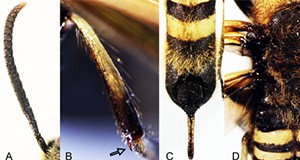
Since it was introduced to North America, the Asian woodwasp has become the most common wood wasp in Florida. It is not considered an economically important pest because it only attacks dying or dead trees, but the species may someday prove to be a pest and its ecological impacts in North American forests remain unknown. This 4-page fact sheet was written by You Li and Jiri Hulcr, and published by the UF Department of Entomology and Nematology, June 2015. (Photo credit: You Li, UF/IFAS)
http://edis.ifas.ufl.edu/in1095
Skyflower: Hydrolea corymbosa
Skyflower is a native wetland plant that produces brilliant blue flowers and can be found throughout Florida. This 4-page facts sheet details skyflower biology, distribution and habitat, propagation, and uses. Written by Lyn A. Gettys and Carl J. Della Torre III, and published by the UF Department of Agronomy, July 2015.
http://edis.ifas.ufl.edu/ag397
Facts about Wildlife Diseases: Rabies
 Rabies is a virus carried by mammals. It kills infected humans and animals if they are not treated shortly after exposure. Rabies can be prevented, but it cannot be cured once symptoms become evident. This 6-page fact sheet explains how rabies spreads, which animals can get it, how common it is, symptoms, what you can do to limit its spread and what to do in case of a possible rabies exposure. Written by Samantha M. Wisely and Holly K. Ober, and published by the UF Department of Wildlife Ecology and Conservation, June 2015.
Rabies is a virus carried by mammals. It kills infected humans and animals if they are not treated shortly after exposure. Rabies can be prevented, but it cannot be cured once symptoms become evident. This 6-page fact sheet explains how rabies spreads, which animals can get it, how common it is, symptoms, what you can do to limit its spread and what to do in case of a possible rabies exposure. Written by Samantha M. Wisely and Holly K. Ober, and published by the UF Department of Wildlife Ecology and Conservation, June 2015.
http://edis.ifas.ufl.edu/uw282
Climate Change: Effects on Salinity in Florida's Estuaries and Responses of Oysters, Seagrass, and Other Biota
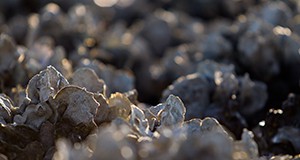 Florida’s economically important estuaries could be heavily impacted by sea-level rise and altered river flow, both caused by climate change. The resulting higher salinity, or saltiness of the water, could harm plants and animals, alter fish and bird habitat, and reduce the capacity of estuaries to provide such important services as seafood production and the protection of shorelines from erosion. This 6-page fact sheet explains the importance of estuaries, salinity in estuaries, and provides examples of stress from extreme high salinity. Then it explores the projected change in climate that could affect salinity in estuaries, how plants and animals would be affected, mitigating effects, and other impacts of climate change on estuaries. Written by Karl Havens, and published by the UF Department of Sea Grant, June 2015.
Florida’s economically important estuaries could be heavily impacted by sea-level rise and altered river flow, both caused by climate change. The resulting higher salinity, or saltiness of the water, could harm plants and animals, alter fish and bird habitat, and reduce the capacity of estuaries to provide such important services as seafood production and the protection of shorelines from erosion. This 6-page fact sheet explains the importance of estuaries, salinity in estuaries, and provides examples of stress from extreme high salinity. Then it explores the projected change in climate that could affect salinity in estuaries, how plants and animals would be affected, mitigating effects, and other impacts of climate change on estuaries. Written by Karl Havens, and published by the UF Department of Sea Grant, June 2015.
http://edis.ifas.ufl.edu/sg138
Managing Conflicts with Wildlife: Living with Coyotes
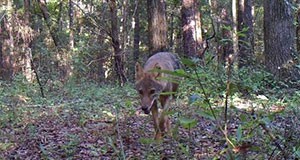 The omnivorous coyote is a relative newcomer to Florida that plays an important role in ecosystems and food webs. Of particular importance and possible benefit may be their potential ability to control populations of pest species such as some rodents. Although rare, there are situations where coyotes can become dangerous or damaging. In this 4-page fact sheet, we present some facts about coyotes, describe dangers and problems they may cause, and provide suggestions on how to cope with these issues. Written by Lauren Watine, William M. Giuliano, Holly K. Ober, Raoul Boughton, Alexander Gulde, Angeline Scotten, and published by the UF Department of Wildlife Ecology and Conservation, December 2014. (Photo: W. M. Giuliano, UF/IFAS)
The omnivorous coyote is a relative newcomer to Florida that plays an important role in ecosystems and food webs. Of particular importance and possible benefit may be their potential ability to control populations of pest species such as some rodents. Although rare, there are situations where coyotes can become dangerous or damaging. In this 4-page fact sheet, we present some facts about coyotes, describe dangers and problems they may cause, and provide suggestions on how to cope with these issues. Written by Lauren Watine, William M. Giuliano, Holly K. Ober, Raoul Boughton, Alexander Gulde, Angeline Scotten, and published by the UF Department of Wildlife Ecology and Conservation, December 2014. (Photo: W. M. Giuliano, UF/IFAS)
http://edis.ifas.ufl.edu/uw397
Managing Conflicts with Wildlife: Living with Deer
Though deer rarely pose problems for people, it is important to understand the issues associated with deer and human-deer interactions. This 4-page fact sheet describes the biology of Florida’s white-tailed deer, the hazards associated with deer, and how to minimize these risks. Written by William M. Giuliano, Holly K. Ober, Lauren Watine, and Raoul Boughton, and published by the UF Department of Wildlife Ecology and Conservation, December 2014.
http://edis.ifas.ufl.edu/uw398
Third Grade Manatee Curriculum

This 19 fact sheet curriculum series provides a series of individual lessons covering manatee biology and ecology, as well as highlighting some of the ways that humans impact and can protect manatees. The curriculum has been written at a third grade level but can be adapted for older or younger students. (Photo credit: Keith Ramos, USFWS)
http://edis.ifas.ufl.edu/topic_series_third_grade_manatee_workbook
Tawny Crazy Ant
As of 2012, tawny crazy ants have invaded 24 counties in Florida, parts of southeast Texas, and other areas of the southeastern U.S. The tawny crazy ant is considered a series pest. This species infests buildings and greenhouses, attacks crops, domestic animals, honeybee hives, displaces native ant species, and disrupts electrical equipment. This 3-page fact sheet covers the tawny crazy ant’s distribution, description, colonies, feeding habits, and pest status and control. Written by S. K. Hill, R. W. Baldwin, R. M. Pereira, and P. G. Koehler, and published by the UF Department of Entomology and Nematology, October 2013.
http://edis.ifas.ufl.edu/in1076
Florida Carpenter Ants
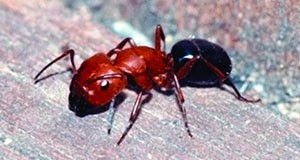 Carpenter ants are in the genus Camponotus, in which up to over 900 species have been described worldwide. They get their common name, “carpenter ant,” because some species excavate nests in wood. Carpenter ants are sometimes called bulldog ants or bull ants. However, not all species in the genus Camponotus are true carpenter ants because some nest in preformed cavities or in soil. This 5-page fact sheet was original published as part of Pests in and around the Florida Home, and was written by R. J. Vazquez, P. G. Koehler, R. M. Pereira, J. Warner, and R. H. Scheffrahn, and published by the UF Department of Entomology and Nematology, October 2013.
Carpenter ants are in the genus Camponotus, in which up to over 900 species have been described worldwide. They get their common name, “carpenter ant,” because some species excavate nests in wood. Carpenter ants are sometimes called bulldog ants or bull ants. However, not all species in the genus Camponotus are true carpenter ants because some nest in preformed cavities or in soil. This 5-page fact sheet was original published as part of Pests in and around the Florida Home, and was written by R. J. Vazquez, P. G. Koehler, R. M. Pereira, J. Warner, and R. H. Scheffrahn, and published by the UF Department of Entomology and Nematology, October 2013.
http://edis.ifas.ufl.edu/in1075
